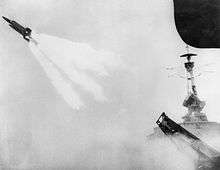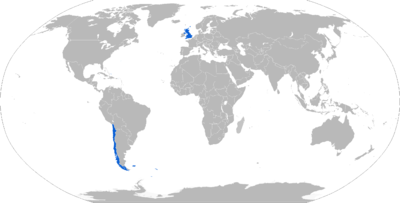Seaslug (missile)
| Seaslug | |
|---|---|
|
Seaslug Mk. II missile | |
| Type | surface-to-air missile |
| Place of origin | UK |
| Service history | |
| In service | 1961 - 1991 |
| Used by | UK (Royal Navy), Chile |
| Wars | Falklands War |
| Production history | |
| Designed |
Mark 1; 1961 Mark 2; 1965 |
| Manufacturer | Armstrong Whitworth |
| Variants | Mark 1, Mark 2 |
| Specifications | |
| Weight |
Mk.1; 2,080 kg Mk.2; 2,384 kg |
| Length |
Mk.1; 6.0 m Mk.2; 6.1 m |
| Diameter |
Mk.1; 0.42 m Mk.2; 0.41 m |
| Warhead |
Mk.1; 200 lb (91 kg) blast Mk.2; continuous-rod warhead |
|
| |
| Engine | 4 solid fuel jettisoned boosters & liquid fuel sustainer |
| Wingspan | 1.44 m |
Operational range |
Mk.1; 30,000 yards (27,000 m) Mk.2; 35,000 yards (32,000 m) |
| Flight ceiling |
Mk.1; 55,000 feet (17,000 m) Mk.2; 65,000 feet (20,000 m) |
| Speed |
Mk.1; 685 mph (1,102 km/h) Mk.2; 1,370 mph (2,200 km/h) |
Guidance system | Beam riding |
Steering system | control surface |
Launch platform | Ship |
Seaslug was a first generation surface-to-air missile designed by Armstrong Whitworth (later part of the Hawker Siddeley group) for use by the Royal Navy. It came into operational service in the 1960s and was still in use at the time of the Falklands War.
Seaslug was intended to engage high-flying targets such as reconnaissance aircraft or bombers before they could launch stand-off weapons. Later improvements meant that it could also be used against ships.
Development
Work on what became Seaslug began in 1949 under 'Stage 1' of the Royal Navy's post-war missile program. The weapon was intended to counter high-altitude nuclear-armed bombers before they could release their weapons. Development made use of on an earlier programme by the Fairey Aviation Company known as "LOPGAP" (Liquid oxygen / petrol guided anti-aircraft projectile), the Clausen Rolling Platform at RAE Aberporth and a Victory Ship specially converted into prototype escort ship, HMS Girdle Ness, was procured. The original system differed in having a triple launcher.[1] The Seaslug Mark 1 finally entered service in 1961 on County class destroyers, each fitted with a single twin missile launcher.
Description
The missile had four wrap-around booster motors which separated after launch. After separation the main motor ignited to power the missile to the target. The booster motors were positioned at the front of the missile, but this unusual arrangement gave acceleration, and, with the motor nozzles angled outwards at 45°, the missile entered a gentle roll at launch, evening out differences in the thrusts of the boosters. This meant that large stabilising fins as used on contemporary missiles in service with the Royal Air Force (Bristol Bloodhound) and the British Army (English Electric Thunderbird) were not required. Once the boosters were clear the control surfaces became active.
Guidance was by radar beam-riding, the beam to be provided by Type 901 fire-control radar. There were 3 flight modes:
- LOSBR (Line Of Sight, Beam Riding), in which the missile flew up a beam that tracked the target
- CASWTD (Constant Angle of Sight With Terminal Dive), with the missile climbing at a low angle and then diving onto a low-altitude target
- MICAWBER (Missile In Constant Altitude While BEam Riding), similar to CASWTD, but with a terminal low-level glide phase so that the Mark 2 variant could be used against ships. This mode suffered from problems associated with the surface of the water reflecting the guidance beam.
Electrical power when the missile was in flight was provided by an flux switching alternator with a six tooth rotor. "The 1.5 kVA Seaslug generator ran at 24,000 rev/min with a frequency of 2,400 Hz."[2]
Service performance
Seaslug was a high-performance weapon in its day, with a single-shot kill probability of 92%.[3] It was, however, limited by the complicated handling arrangements and since each County class ship carried only a single fire-control radar only one target could be engaged at once, though two missiles could be fired against it.
The cost of an individual Seaslug missile round in 1961 was approximately £50,000.
Variants

There were two main variants of the Seaslug:
Mark 1 (GWS.1)
The Seaslug Mark 1 was powered by the solid-fuel Foxhound sustainer motor[lower-roman 1] and Gosling booster motors. It had a radio proximity fuze and 200 lb (91 kg) blast warhead. The Mark 1 was a beam rider missile, meaning the target had to be continually illuminated by the directing radar, so the system was limited to engaging only the number of targets that there were radars to track and lock on.
- Particulars
- Attack Velocity: 685 mph (1,102 km/h)
- Range: 30,000 yards (27,000 m)
- Ceiling: 55,000 feet (17,000 m)
Mark 2 (GWS.2)
The Seaslug Mark 2 was based on the aborted Blue Slug programme to develop an anti-ship missile using the Seaslug missile and guidance system. The project was cancelled in favour of the Green Cheese missile but other project developments were incorporated into what became the Mark 2. It had improved low altitude performance and a limited anti-ship capability and entered service in 1965. The Mark2 utilized an improved beam-riding guidance system.[lower-roman 2] It was powered by the Deerhound sustainer motor, with Retriever boosters. Control was by a modified Type 901M radar and it had an improved infra-red proximity fuze and a continuous-rod warhead with a smaller, 56 lb (25 kg), explosive charge and large steel penetrator.
- Particulars
- Attack Velocity: 1,370 mph (2,200 km/h)
- Range: 35,000 yards (32,000 m)
- Ceiling: 65,000 feet (20,000 m)
Nuclear variant (not built)
In addition, a nuclear-armed variant was planned using a low-yield fission warhead code-named Winkle. Winkle was never built as it was quickly supplanted by Pixie, a very small unboosted warhead with an all-plutonium fissile core tested at Maralinga, which was, in turn, replaced by Gwen - a British version of the US W54 Gnat unboosted warhead of approximate yield 1/2 - 2 Kiloton (kt). The final warhead choice was Tony - a UK version of the W44 Tsetse boosted warhead, but all nuclear options for Seaslug were subsequently abandoned, and no nuclear-armed variant of Seaslug was ever deployed.
Operators

Royal Navy
The County-class destroyers were specifically built to carry Seaslug and its associated control equipment. The magazine was positioned amidships and missiles were assembled in a central gallery forward of the magazine before being passed to the launcher on the quarterdeck. The handling arrangements were designed with a nuclear-war environment in mind and were therefore entirely under cover.
During the Falklands War Seaslug was only launched once against an aircraft target, by HMS Antrim, and did not hit. This is hardly surprising, as the Royal Navy considered the system to be obsolete and the low-level attacks experienced in the Falklands War were outside the missile's operational capacity. It was fired again in anger, this time against an Argentine radar at Stanley airfield that the Royal Air Force had been unable to destroy. During a shore bombardment HMS Glamorgan triangulated the last known position of the radar with her ESM and fired a Seaslug. She later fired several at the runway to cover it with debris which would have damaged any aircraft attempting to land or take off. Results, if any, are unknown, but the impressive fireworks display associated with the launch sequence was something of a morale booster to the troops ashore.
Seaslug was withdrawn as the Counties were decommissioned. HMS Fife was converted to a training ship, and had her Seaslug systems removed, freeing up large spaces for classrooms.
Chilean Navy
Some of the County-class destroyers were sold to Chile for the Chilean Navy. The system was decommissioned after the rebuild of the four ships purchased by Chile in the early 1990s.
Former operators
Notes
References
- Naval Armament, Doug Richardson, Jane's Publishing, 1981, ISBN 0-531-03738-X
- United Kingdom Aerospace and Weapon Projects
- The Falkland Islands Conflict, 1982: Air Defense Of The Fleet
- Winkle - warhead for the planned nuclear variant
- Seaslug: The most missile in the least space Flight 1958 article by Bill Gunston
External links
| Wikimedia Commons has media related to Seaslug (missile). |
- Sea Slug Video
- "Seaslug - the Most Missile in the Least Space" a 1958 Flight article by Bill Gunston
- "Shell for the Seaslug" a 1959 article on Seaslug in Flight magazine
- "Seaslug Story" a 1962 Flight article on the Seaslug
